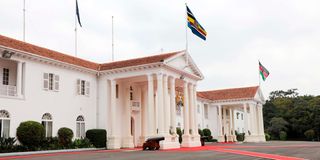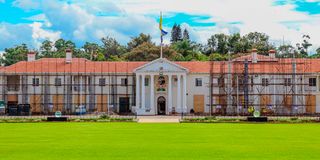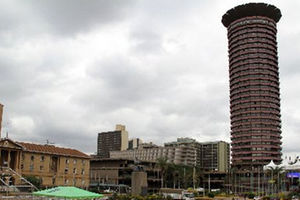
A view of State House in Nairobi.
When Sir Herbert Baker designed what is now Kenya’s State House, he sought to etch his legacy into the landscape much as he had done in New Delhi and Pretoria.
His architectural signature, described by Elspeth Huxley as one of "solid, enduring buildings with walls of whitewashed stone and roofs of red close-socketed tiles," was meant to symbolise both permanence and grandeur.
There was a huge uproar in London when Nairobi constructed Governor’s House at a cost of £90,000 in 1926.
The new Governor, Sir Edward Grigg, had carried the blame (and now the accolades) though the man who had originated the idea was Lord Delamere and pushed it through the Legislative Council. Grigg found a budget and invited Herbert Baker to do the work.
“I was Governor, though in no way responsible for its inception, bore the brunt of it...there were some really offensive jibes directed at me in a much-publicised speech by Colonel Ewart Grogan... Lord Delamere never turned a hair during all this tribulation; he told his elected colleagues to remember that they were denouncing a proposal for which the true responsibility was not the Governor’s but theirs.
It made no difference; they went on, and I must give them this much reason that I could have squashed the whole proposal if I had thought it wrong. The real trouble was that I thought it right and that they wanted to ‘pass the buck’ from themselves to me.”
That was the controversy that stalked the building of State House building – a very sweet history on colonialism.
Ruto reforms
That President William Ruto, in his wisdom — or lack thereof — has undertaken to reshape one of Sir Herbert Baker’s architectural masterpieces, the State House, speaks volumes about our collective regard for heritage.
The State House architectural form has fallen victim to philistinism embedded in the Kenya Kwanza regime. Had there been public participation, some of us could have said no – and with a reason.

President William Ruto makes his address during the Ministerial performance contracts signing held at State House.
In his autobiography titled Architecture and Personalities – which is quite rare to find – the British architect hoped that “the Government House (as State House was known then) we built will at last come to the full dignity for which it was designed.” Sadly, it has not.
Also Read: State House upgrade to cost taxpayers Sh795m
Retaining historic buildings as heritage sites, rather than subjecting them to redesign, is paramount in safeguarding history, culture, and national identity.
There is a reason I am saying this. These edifices stand as tangible echoes of our past, preserving the architectural ingenuity, craftsmanship, and narratives of bygone eras, however painful.
Baker, a celebrated Commonwealth architect, had also been invited by Governor Grigg to give Kenya some modern buildings and plan the city of Nairobi.
His contract included designing two Government Houses in Nairobi and Mombasa, the modern-day Supreme Court of Kenya building, Kabete Secondary School (later Prince of Wales School and now known as Nairobi School), the East African Railways Headquarters, and the European School (now Nairobi Primary School).
His other project was Jamhuri High School, then known as Government Indian School, Nairobi and later as Duke of Gloucester School. He also did plans for a Legislative chamber and a Government Secretariat. These were to be in Milimani, Nairobi, and both had a “high dome as the symbol of the capital.”
Edifices
Governor Grigg, a man deeply obsessed with edifices, expressed his fascination with fine buildings in his autobiography, Kenya’s Opportunity: Memories, Hopes and Ideas.
It is a legacy he wanted to leave behind and would be surprised today on the shape that Nairobi took.
He wrote: "Every great civilisation has left its memorial in buildings of some sort, even those early ones in Mesopotamia which had little material to build with but wattle, clay and thatch.
Not that our human forebears built to impress posterity; they built to express themselves and to make a dignified setting for the life of the people and the State."
The only regret that Grigg faced was that his successors did not continue with his projects.
He blamed his successor Sir Joseph Byrne – and to an extent the World War II: “The most serious of (Governor Byrne’s) failures was the abandonment of Central Government Offices of which I had chosen the site and laid the foundation stone…my plan was to house the four main departments- Secretariat, Law, Treasury, and Native Affairs – together round an open court.”

The ongoing renovations at State House, Nairobi in this picture taken on May 3, 2024.
All these had been paid for but never built, Governor Grigg later wrote: “As to the foundation-stone I have a paper-weight presented to me when I laid it (and) I believe, is all that remains of a design, already paid for, which would have dignified Nairobi as Sir Herbert had dignified Pretoria.
Whether askaris still wander about Nairobi with official files, as they used to do, I do not know; but I strongly suspect that many ‘top secret’ documents have in recent months passed through the hands of Mau Mau terrorists (as the colonialists referred to the freedom fighters) on their way from one office to another.”
By independence and till today, government offices and ministries are still scattered in various parts of the city.
It is a bureaucratic nightmare. Rather than demolish the old Government House, and I have seen various images shared online, Grigg decided to design a new building – the one President Ruto has reshaped.
He says as much in his book: “I designed a new Governor’s House at the old site, leaving the existing unsuitable building as servant’s wing.”
This was, perhaps, Grigg’s idea for he did not want Nairobi to face the fate of Rome, as he writes in his autobiography.
"They built layer upon layer, each period superimposed upon the previous one and marauding its monuments," he observed with dismay.
But today, President Ruto has imposed his own era upon State House, reshaping its legacy with a heavy hand, and we find ourselves reenacting this very cycle—obscuring history beneath new layers of political philistinism.
It is important to think of the future and the past and offering linkages. When Baker was planning Nairobi, he thought that it would be the capital, in future, of a united East Africa.
There is a reason that Baker’s buildings within the Commonwealth have not been interfered with. They offer unique linkages to other similar forms that were prevalent in 1920s and 1930s.
For instance, do you know that most of the early tiles in Nairobi and Mombasa were shipped from India? Such buildings lend a city its aesthetic soul, bestowing upon it a singular charm that cannot be manufactured anew.
I have heard the argument that State House is a colonial relic and that change in its architectural form was inevitable. I have been called a “tribalist” on X for opposing this re-roofing of State House.
But if colonial legacy were a reason for erasure, then one must reckon with the inconvenient truth: the very nation of Kenya is, in itself, an artifact of colonial cartography—a construct of imperial imaginations drawn on the map with little regard for the people it sought to contain.
Let me tell you a story on vision. When Governor Grigg first arrived in Nairobi, he says he was struck not by its promise but by its profound disorder. He lamented that the Nairobi he found “had not given any thought to style or permanence, though the ambitions of those for whom it served as capital were already high ranging.”
He described Nairobi’s “prevailing characteristics” as consisting of “shoddiness, paltriness in building, and for ways of movement either adhesive mud or choking dust.” That was in 1925.
He thought that a Nairobi without fine architecture, would not play its role in Africa.
“This Buffalo-Bill frontier-post setting seemed to me bad; instead of teaching the young to value themselves and the heritage they were born to improve and enrich, it encouraged hand-to-mouth, poor-white sloppiness and sloth which spelt degradation for the unfolding promise of youth. I made up my mind within a week of my arrival to revolutionise all this."
If you look at Nairobi today, you can see how the pre-1925 “shoddiness [and] paltriness in building” has overshadowed the fine planning. As we witness the relentless reshaping of our architectural heritage, one truth is undeniable history, once altered, rarely reassembles itself. I rest my case.
John Kamau is a PhD candidate in History at the University of Toronto, Canada.
[email protected]; On X: @johnkamau1







